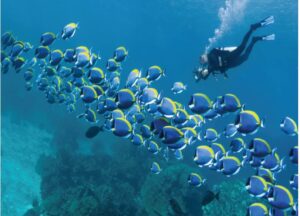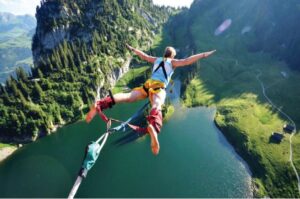Exploration and invention are one of the primary instincts of human beings. In this regard, tourism and adventure tourism are as natural to humans today as was the nomadic lifestyle to them thousands of years ago. Adventure tourism can be defined as the movement of people from one place to another but in a characteristic manner that involves exploration or travel to zones and areas that are uncharted, possibly hostile or risk laden, remote, exotic and often deserted – basically doing activities outside one’s comfort zone.
Adventure tourism is a much sought-after activity especially among the youth today and India with its geographical diversity offers an unimaginable range of adventure tourism activities. These activities are growing in popularity each day and social media has contributed in a big way in drawing more and more people to it. The potential of adventure tourism in India is immense – water sports such as parasailing or jet skiing in Goa, rock climbing in Aravalli Hills, rappelling and canyoning in the Ganges, scuba diving in the waters of the Andaman and Nicobar Islands, bungee jumping and rafting in Rishikesh or wildlife safaris in one of the many national parks – the list is endless.
The rush of adventure tourism
Travelers and explorers seek new and different experiences all the time which is why the popularity of adventure tourism will only increase with time. It could include any nature-based activity, physical activity, cultural exchange, etc. offering thrill-based pleasure. Contrary to popular belief, adventure tourism is very diverse in itself and does not include only ‘extreme’ physical activities such as bungee jumping or scuba diving. There is much more to the term than just ‘high- risk’ physical activities.
For the unversed, any activity that involves connecting with a new culture or exploring a new landscape and, at the same time, being physically active comprises adventure tourism.

So, adventure tourism is not just about being taking risks or testing the limits, it is also about knowing those limits and respecting them. Today, with the fast-growing middle class and upper middle class that are seeking new horizons and beating the conventional idea of a family vacation, more and more options and locations of adventure tourism are opening up every day.
Also, more and more professionals are now working towards striking a work-life balance and make it a point to take occasional breaks from work to push off to a ‘new’ location for a few days or try a new adventure activity. Access to the internet and social media has only helped further these ‘thrill seekers’ in finding their ultimate adventure activity for that adrenaline rush.
Additionally, with the Covid-19 pandemic normalising the work-from-home culture, there is an increased flexibility being offered to the working population who are making the most of it. Be it spending time with your loved one, with your children or with friends, people are taking every opportunity available to get away and do something new and thrilling.
The diversity of adventure activities
In India, like in most other nations, there are three main categories of adventure activities available – Land based, Air based and Water based adventurous activities. Some of the activities included in these three kinds of adventure tourism include:


Land based Adventure Tourism offers several options to adrenaline junkies that includes but is not limited to All Terrain Vehicle Tours, Personal Light Electric Vehicle Tours, Camel Safaris, Horse Safaris, Jeep Safaris, Wildlife Safaris, Bungee Jumping, Trekking, Mountaineering, Rock Climbing and Artificial Wall Climbing, Cycling Tours, Motorcycle Tours, Nature Walks and Bird Watching, Skiing and Snow Boarding, Zip Wires, etc.
Water based Adventure Tourism comprises, Kayaking, Sea Kayaking, Jet Skiing, Rafting, River Cruising, Scuba Diving, Snorkelling, etc. And, Air based Adventure Tourism includes many activities such as Air Safaris, Ski Diving, Hot Air Ballooning, Paragliding, Hand Gliding, Para Motoring, Parasailing, Kite Boarding, etc.
All government-approved adventure tourism activities have to follow specific protocols and guidelines. These are based on providing Standard Operating Procedures (SOPs), instructions for Risk Mitigation, Emergencies, etc. These also include safety briefing, emergency rescues, medical precautions and concerns, etc. It’s important that these activities are conducted by trained personnel with the necessary permissions, risk management strategy, audits, etc.
Attractive locations for adventures
For those who are bored of the monotonous daily grind of life, adventure tourism offers the best break. India, unknown to many, is home to many locations and zones that offer the perfect reason to travel and explore. The length and breadth of the country, with the great geographical diversity, offers several exotic and wild adventure tourism spots.
Those engaged in the industry or dependent on it economically have been hoping that with the opening of the sector and with the pandemic behind, there will be a big boom in the sector. It’s one of the best ways to break the lockdown blues.
Many states rich in adventure destinations in India such as Goa, Uttarakhand, Andaman and Nicobar Islands, Kerala, Himachal Pradesh, etc., are making sure they leave no stone unturned to attract tourists, especially after the lockdown.
The Andaman and Nicobar Islands, as far as they may be from mainland India, are extremely popular for offering some of the best water sports and water-based sports and adventure activities in India. A trip to the islands would be incomplete without ‘indulging’ in snorkelling, scuba diving or parasailing. The beautiful and exotic islands are a paradise for those seeking water based adventure activities.

The Spiti Valley – a cold desert mountain valley located in the Himalayas in the north-eastern part of Himachal Pradesh – is a haven for adventure seekers. The valley offers one of the most difficult treks in India. The harsh terrain makes it a challenging activity and also a popular one for those looking to go the extra mile and for a memorable experience. The Spiti Valley trekking span is 55 km (approximately) starting from Langza and ending at Dhankar and takes about five days.
Nature lovers don’t miss an opportunity to visit Kaziranga National Park in Assam. The experience of coming face to face with the endangered Indian Rhinoceros cannot be explained in words. The park has more than 2,000 rhinos where one can take a jeep safari or an elephant-back ride to spot them. The park also has elephants, water buffalos, etc.
A hub for adventure activities
Goa happens to be one of the most sought-after destination in India for a vacation. The very sound of Goa means vacation. Interestingly, Goa is popular for tourism of all kinds, including adventure tourism. The beaches, lagoons, national parks, etc. offer a wide range of adventure activities.
Dudhsagar Falls, located on Mandovi River approximately 70 km from Panjim, is perhaps the most visited trekking spot in the state and also the most beautiful. One of the highest waterfalls in India, they are an ideal location for a challenging trek culminating into a breathtaking view.
Goa also offers a stream of options for scuba diving, parasailing, rafting, kayaking, trekking, sailing, hot air ballooning, jet skiing, windsurfing, dinghy sailing, etc. Adventure tourism in Goa is fast becoming a trend and getting extremely popular among the young travellers who are constantly looking for something new.


 Bungee Jumping – a popular adventure sport
Bungee Jumping – a popular adventure sport